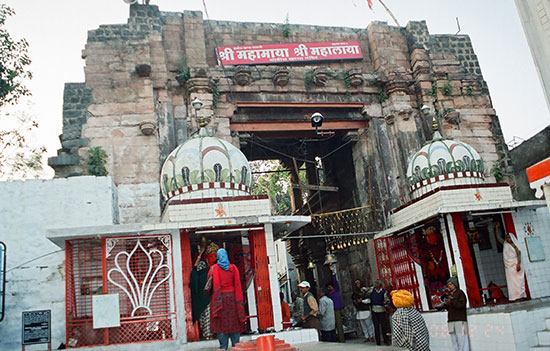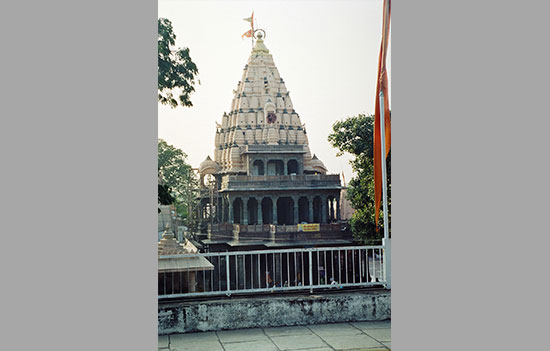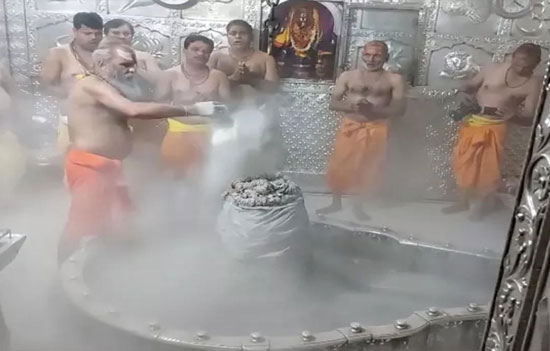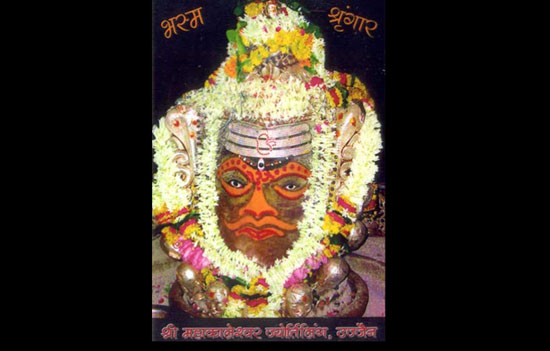- Know
about the history, architecture of Mahakaleshwar Temple, Bhasma Aarti,
interesting facts and the newly made Mahakal Corridor.
Mahakaleshwar
temple is one of the 12 Jyotirlingas of Lord Shiva. It is situated on the banks
of holy river Kshipra and near Rudrasagar Lake in the ancient city of Ujjain in
Madhya Pradesh.
History
There
are many legends associated with this temple. Its splendour is depicted in
ancient Hindu scriptures. Sanskrit poets like Kalidasa have described this
temple in poems.
Ujjain
was once the focal point for calculating Indian time. Mahakaal (Lord Shiva) is
the unique ruling deity of Ujjain.
It
is believed to have been built in the 6th century AD by Kumarasena, the son of
king Chandpradyot. The temple suffered many attacks.
 Old entrance of Mahakal Mandir. U see 24 Khamba Mata ka Mandir.
Old entrance of Mahakal Mandir. U see 24 Khamba Mata ka Mandir.
It
was demolished by Sultan Shams-ud-din Iltutmish in 1235 AD. Later a five storey
temple was restructured. The Scindia clan started restoring the temple in the
18th century. It was renovated by successive dynasties from Shunga, Kushana and
Satavahana to Gupta, Parihar and Parmara.
The
present structure was built by the Maratha commander Ranoji Shinde under the
rule of Peshwa Bajirao in 1734 CE. After Independence, Mahakaleshwar Devasthan
was placed under the collectorate office of Ujjain.
First published in
Journal of Bharatiya Vidya Bhavan.
Architecture
This
temple displays different ancient style of architecture like Bhumija, Chalukya
and Maratha styles.
 Current temple built by Ranoji Shinde (Scindia).
Current temple built by Ranoji Shinde (Scindia).
It
has a tall spire (Shikhara) with
beautiful carvings. The temple has five levels, one of which (Garbhagriha) is
underground which is actually the first floor. There are other idols too next
to the Shivalinga of M a h a k a l e s h w a r-Goddess Parvati to the north,
Lord Ganesha to the west, Nandi to the south and Lord Kartikeya to the east. On
the second floor is the Omkareshwar Linga. ‘Nagachandreshwar’ is situated on the 3rd floor i.e. Lord Shiva and Goddess Parvati seated on a ten-hooded snake and surrounded by other statues.
There is a large water tank or ‘kund’ inside the temple campus known as Koti Tirtha. It is built in
Sarvatobhadra style which is believed to be sacred. The idols of Ganesh,
Kartikeya and Parvati near Koti Tirtha are covered by silver plates.
Festivals celebrated
1. Kumbha Mela is the largest religious gathering which takes place once in 12 years in Ujjain, Allahabad, Nashik and Haridwar. Pilgrims and sages take a holy dip in Kshipra River and Ramlilas, Raslilas and grand processions of sadhus are conducted. The festival continues for 1 ½ months.
2. Maha Shivratri is the most important festival
during the Hindu month of Magha (Feb/ March). Puja and prayers are held
throughout the night. A huge fair is held near the temple.
3. The holy Shravan (Sawan) month is the best time to visit.
Every Monday, there is a procession of Lord Shiva. The sacred procession of
Mahakaal in His palanquin to the river Kshipra on the last Monday of Sawan is
called Shahi Savaari. It is a
spectacular procession with the participation of many devotees and sages.
4. Kartik Mela during the Hindu month of Kartik
(Nov/Dec).
5. Hari Hara Milana on Vaikunta Chaturdashi. This
signifies the meeting of the two Gods-Lord Shiva and Krishna.
Bhasma Aarti

This
is a famous ritual of Mahakaleshwar temple. It is an offering to Lord Shiva
with ashes (Vibhuti or Bhasma). It starts before sunrise at 4 am. The sacred
ashes from the first pyre that is burnt is brought from the ghats every day and
applied to the Shivalinga.
Lord
Shiva is Adi Yogi and Bairagi. He adorns His body with ashes.
The belief is that Lord Shiva is also like ash which is pure, non-dual,
imperishable and unchangable. It also symbolises that everyone has to merge
into Lord Shiva ultimately after death. There are certain rules to follow for
men and women to participate in Bhasma Aarti. Men have to wear only cotton
dhotis. Men can see aarti but cannot do it. Only priests are allowed to perform
it. Women have to wear saris. When Bhasma is applied to the Shivlinga, women
have to cover their face with a veil. It is believed that at this time, Lord
Shiva is in a formless state and women are not allowed to see this form.
 Bhasm Shringar.
Bhasm Shringar.
Some Interesting Facts
As
mentioned in ancient Hindu scriptures, this temple is built by Prajpita Brahma
himself.
1. It is a
self-manifested linga (Swayambhu).
2. It is the only jyotirlinga that faces south, hence it is known as Dakshinamukhi (All other lingas face
East). This is because the direction of death is believed to be south. Lord
Shiva is the master of death. So people worship Mahakaleshwar for a long life
and to prevent untimely death.
3. It is also one of
the 18 Mahashakti peethas. Devotees believe that the upper lip of Devi Sati
fell here. The Goddess is popular as Mahakali here.
4. It is said that the Mahakaleshwar temple is home to around 33 crores of Hindu gods and goddesses. It is the one and only temple among the 12 Jyotirlingas which has multiple temples in its vicinity.
5. Lord Nagchandreshwar on the 3rd floor
of the temple is opened to the public only once in a year i.e. on Nag Panchami.
6. Tantric tradition
is found only in this temple among the 12 jyotirlingas. The tantric Shivnetra tradition is preserved here. It is said to have ‘Spiritual Shivnetra’.
7. It is said that since ancient times, after king Vikramaditya no king could stay here for a single night. Even today that is followed. No king or senior personality can stay here as Lord Mahakaal is the sole king of this land.
8. It is believed
that the prasad offered to the deity here can be reoffered, unlike in other
temples.
9. It is said that
by visiting this temple once, anyone can attain salvation. It is one of the
most sacred pilgrimage places for Hindus. As per the book, Koti Rudra Samhita, those who pray in this temple stay free from
unnatural death.
Mahakaleshwar CORRIDOR
The
first phase of the Mahakaleshwar temple corridor development project was
inaugurated on October 11, 2022. This corridor is about 920 meters long and
decorated with unique artefacts and sculptures.
The
project has a park, solar lighting, multi-storeyed parking for vehicles,
facility centre for pilgrims and a night garden. More than 1 lakh trees have
been planted here.
A
giant gate of Mahakaal corridor is built near Triveni Sangrahalaya. The grand entrance includes Sapta Rishi, Navagraha Mandal, Tripurasura slaughter, Shiva enshrined in a lotus pool and 108 pillars depicting Lord Shiva’s Ananda Tandava, Shiva Stambh and huge statues of Nandi. There are about 200 idols in the corridor. The 108 pillars are equipped with beautiful lighting and state-of-the art cameras showcasing Shiv Tandav Shlokas and 52 murals depicting various stories. There is a wall mural of 800 meters. Free ecards are available for the elderly, children, and the differently-abled. Devotees will be able to scan and listen to the story of each mural painting, using these e-cards.
The
12 Jyotirlingas situated at various places such as Somnath, Nageshwar,
Bhimashankar, Trimbakeshwar, etc. are believed to be the embodiments of the
endless and matchless power of Lord Shiva who is the Lord of all Lords (Devon ka Dev Mahadev). They are all Swayambhu or self-manifested forms
deriving power (Shakti) or cosmic energy from within, as against other lingams
or statues which are established doing rituals and infused with mantra shakti.
Kaal
means time and death. Thus ‘Mahakaal’ means Lord of time and death. Lord Shiva is the destroyer or transformer of all elements. There is nothing beyond Him—no elements, no dimensions and not even time. Even Kaal (Lord of Death) fears Lord Shiva.
Lord
Shiva is limitless, unchanging, formless and transcendent, beyond time and
death!
This article was first published in the Bhavan’s Journal, 15 December 2022 issue. This article is courtesy and copyright Bhavan’s Journal, Bharatiya Vidya Bhavan, Mumbai-400007. eSamskriti has obtained permission from Bhavan’s Journal to share. Do subscribe to the Bhavan’s Journal – it is very good.